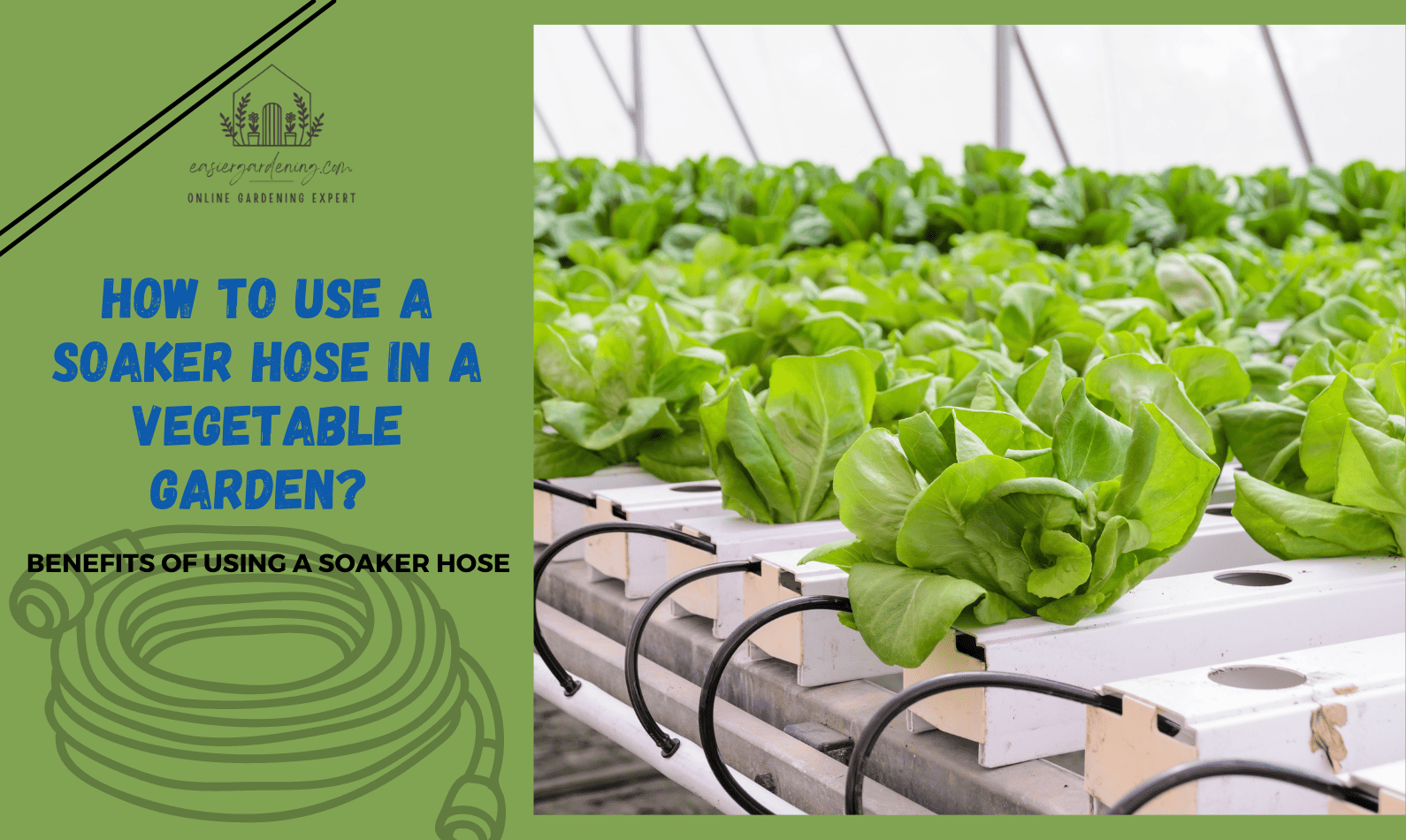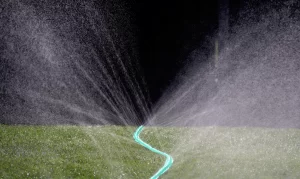How To Use A Soaker Hose In A Vegetable Garden? With a soaker hose, you can easily guide water directly to where it is required without any hassle. However, in order for a soaker hose to be a successful choice for you, you must first learn how to use it properly. Let’s go over how to set up your soaker hose, where it should go, and how much you should run it for the best coverage. Let’s get started! There’s a lot of ground to cover (so to speak), so let’s get started!
Contents
- What Is A Soaker Hose?
- Benefits Of Using A Soaker Hose
- Soaker Hose Vs. Drip Irrigation
- Soaker Hose Installation
- Soaker Hose Components
- Faucet End Components
- Layout & Planning
- How To Use A Soaker Hose In A Vegetable Garden? How Often Should You Water?
- Is your Soaker Hose not Watering Evenly?
- Are you finding your Beds are too dry?
- Did One of your Hoses stop Working?
- Final Thought: How To Use A Soaker Hose In A Vegetable Garden?
What Is A Soaker Hose?
Soaker hoses, as the name suggests, are hoses that will soak your plants. These hoses, which are typically made of porous rubber material, are intended to allow water to ooze into your garden over time. This results in deep watering rather than shallow surface watering.
The material used is frequently sterilized and repurposed from recycled rubber from used tires. When you purchase soaker hoses, you are also endorsing the recycling movement and being environmentally friendly! Unlike other types of irrigation, a soaker hose seldom sprays water directly onto the plant. This is very helpful to the majority of people.
To be sure, there’s nothing wrong with using a sprinkler, and many people do! However, if you have a plant that is prone to diseases such as powdery mildew or other fungal diseases that spread quickly in wet conditions, a soaker hose is much better than other types of irrigation.
There are several other advantages of using soaker hoses, so let’s take a look at some of them now.
Benefits Of Using A Soaker Hose
- Since soaker hoses do not spray, they allow the consumer to use less water. There is no waste since the water flows directly from the hose into your yard. Furthermore, the hose’s sluggish oozing avoids runoff and erosion in the yard.
- Soaker hoses, as previously described, hold water away from plant foliage, and this has a distinct advantage. When there is less moisture on the plant, it is less susceptible to fungal disease. However, they also help to regulate soil moisture, which can help to avoid soil-borne disease!
- Weeds can be managed by using soaker hoses. Weeds that are not in the range of the moisture pattern can suffer from a lack of water as water is concentrated along with the hose. This will hold weeds at bay, at least in part!
- There is also the benefit of saving time. You can set it and forget it, so you don’t have to fill watering cans or keep a hose sprayer, and your garden can effectively water itself. Even if you don’t have a timer, simply turning on the faucet and returning later is easy.
- Finally, it’s so simple? Because the precise watering pattern is extremely simple to manage. Watering is a piece of cake once you’ve determined your frequency. It takes some practice, but you can do other things when your garden is being watered!
Soaker Hose Vs. Drip Irrigation
- The word “drip hose” refers to a variety of irrigation methods, all of which begin with a flexible yet solid hose. It is typically made of plastic and can be punctured along its length at regular intervals (causing it to drip) or fitted with special attachments that guide a drip or spray.
- Drip hoses have a predetermined spacing for watering. For example, if you are growing grapes, you can set up a drip hose to directly reach the root zone of each grapevine, with long spaces of unbroken hose in between the vines.
- On the other hand, a soaker hose releases water over its entire length, resulting in an even strip of water release. This can be very effective in a home environment, and it is especially useful if you have a large number of plants in a small space!
Soaker Hose Installation
Let’s go over everything you’ll need to know before installing your soaker hose system. It is critical to understand the various components needed to connect it all together!
Soaker Hose Components
Aside from the soaker hose, you’ll need a few other parts to get all connected.
- First and foremost, you must determine how the water will be routed from the faucet to the soaker hose. Simply extend a garden hose over to the bed that needs to be connected. Building an in-ground network of PVC plumbing pipes to help direct the water is another option.
- Assuming you’ve already determined how the water can get to the beds, you’ll need a tubing adaptor (often included in kits). This is something that screws onto the end of the hose or pipe to limit the flow to a size that will fit into the soaker hose.
- You may also need a set of couplers. You can need tee couplers, corners, or straight pipes, depending on your orientation.
- A tee fitting may be used to create a loop that can be wrapped around a tree or specific plant. It can also be used to draw lines around a large bed. Corners are visible because they guide the flow of water around a corner. Straight pipes connect two hoses.
- A soaker hose end cap will be needed for the open end of the hose. End caps are not needed for those installing ring-shaped soaker hoses, but they are required if you have a lot of straight hose extensions.
- DIYers can also need a non-porous hose to convey water from their beds to the ideal soaker starting point. Choose one that is the same diameter as your soaker hose so that the couplers fit!
Faucet End Components
Depending on your setup, a range of options is available at the faucet end.
- It is always a good idea to have a soaker hose pressure regulator on hand. A pressure regulator ensures that water is slowed before touching the soaker hose, preventing tears or bursting hoses.
- Soaker hose water pressure levels differ, despite the fact that many residential water systems already control the pressure to some extent. Others are only rated for 10 PSI, while others can withstand far higher water flow rates. Using a pressure regulator if you have a low-pressure soaker hose.
- A water filter is another choice for the faucet end. This is particularly useful if you have hard water with mineral deposits, as it prevents those deposits from entering your soaker hose system.
- If you plan to install several soaker hoses, a hose splitter installed after the pressure regulator can assist in breaking up your watering pattern into separate locations. The splitter allows you to run several hoses from a single faucet.
- Finally, there is the option of installing a timer on the faucet side, which we will discuss further below.
Layout & Planning
There are a few main factors to consider when deciding how to install soaker hose systems in your yard.
- First and foremost, what do you need to water? Do you want to use soaker hoses in raised beds, or do you want to irrigate flower beds? Soaker hoses for trees or a soaker hose for watering the vegetable garden? You’ll need to figure out where you’ll put these.
- Knowing how far to run the soaker hose is also critical. In general, a soaker hose should not be much longer than 25 feet in length for optimal functionality. Although one can be made to work up to 50 feet in length, the second half has significantly less water flow than the first.
- Tree soaker hoses may be wrapped around the base of the tree in a loose loop. Going out 2-3 feet from the trunk is a reasonable diameter for a more mature tree. Young trees will get it 6-12 inches closer to the trunk. Place it as far away from the trunk as possible.
- If you only have a few plants to encircle, a soaker hose vegetable garden layout can be achieved in a loop shape. If you have a lot of plants in rows, something a little more intricate may be in order.
How To Use A Soaker Hose In A Vegetable Garden? How Often Should You Water?
The short answer is that it depends on your device and its configuration. Most gardens need around 1 inch of water per week. The flow rate of your soaker hose should be specified on the roll of the hose or package packaging that you buy. Flow rates are usually faster in narrower soaker hoses.
What is the average amount of water used by a soaker hose every hour? This is another difficult but popular issue. Again, this is dependent on the soaker hose. It will use less water overall if you use a short soaker hose. A larger diameter hose needs more water to fill and hence consumes more.
Learn more about How to Clean Your Hedge Trimmer Blades?
You can conduct a water test by burying an empty can or small plastic tub in the soil underneath your soaker hose. Switch on the hose and time how long it takes to fill the container’s bottom 1 inch deep. That is how long your soaker hose should be run on a weekly basis. Watering more often in the summer is necessary due to evaporation caused by hot weather. You can need as much as 2′′ per week. If you mulch over your soaker hose, you will experience less moisture loss than you would without the mulch, allowing you to conserve more water.
Frequently Answered Questions
Is your Soaker Hose not Watering Evenly?
The most common issue is that you’re losing pressure at the end of an overly long hose when this occurs. If you want a longer hose, choose one with a smaller diameter that needs less water to fill (such as 1/4′′ instead of 1/2′′).
Pick the Best Natural Fertilizer for Vegetable Garden
Even so, it’s necessary to avoid using a soaker hose that’s more than 50 feet long, and I personally avoid using one that’s more than 25 feet long. Instead, I’ll use several extensions from a solid hose and no more than 25 feet of soaker hose per attachment.
Are you finding your Beds are too dry?
You could be experiencing excessive evaporation, which is normal if your soaker hoses are exposed. To stop this, cover your soaker hoses with mulch. 2 inches of mulch can help reduce evaporation.
Did One of your Hoses stop Working?
It may be clogged, which is common in areas with hard water. Filters can be used to prevent calcified deposits from washing into your hoses. You should flush the hoses in the spring and fall to keep them from being clogged.
Choose the Best Insecticide for Vegetable Garden
It can be difficult to remove calcified deposits from your soaker hose’s porous surface once it has become deeply clogged. At that point, you can substitute soaker hose segments as required. It is best to avoid these at all costs and to be vigilant in hose maintenance.
Final Thought: How To Use A Soaker Hose In A Vegetable Garden?
Now that you know how to use a soaker hose, it’s time to start planning your installation! In your yard, do you use soaker hoses? If so, what is your preferred configuration? Please describe your setup in the comments!




